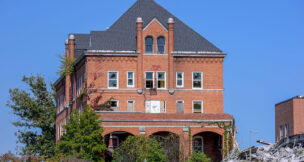Museum founder is trying to start medical school
Trying to start Southern Virginia’s first medical school is more than a full-time job.
“It’s a never-ending thing,” says Noel Boaz, president and founder of the Integrative Centers for Science and Medicine, a coalition of nonprofit educational, research and charitable institutions in Martinsville. Boaz has a doctorate in biological anthropology and a medical degree and serves as an affiliate research professor of anthropology at Virginia Commonwealth University in Richmond.
This isn’t Boaz’s first time launching a major project. He founded the Virginia Museum of Natural History in Martinsville, raising $8.1 million to open it as a state museum in 1989. Now he’s embarked on a $1 million campaign to launch The College of Henricopolis School of Medicine, named after Virginia’s first institution of higher education. “Initially, it’s a slow trickle, and slowly people start to feel confident it is going to work, and you get significantly more contributions,” Boaz says.
One trickle has come from Mervyn King, a retired anesthesiologist, and his wife, Virginia, who own a number of properties in Martinsville. They recently donated a 10,000-square-foot building to Boaz’s cause. The building is an important factor, Boaz says, since it’ll help stimulate further fundraising. “This is a beginning building for us,” Boaz says. “We will have to have much more space as we move forward.” Though the medical school project has no full-time staff, Boaz expects employees to come on board in the next couple of months, including instructors, an administrative assistant, registrar and grants officer.
The medical school would be Virginia’s fifth school awarding doctor of medicine degrees. Its program would entail three aspects: education, research and clinical service. The school would focus on producing primary-care doctors because that’s currently the need in America and will be an even greater need once mandates in the Affordable Care Act kick in next year, Boaz says.
The school hopes to offer a clinical gross anatomy course this summer, which would be available to 24 medical students from another country. The course would be comparable to one offered in a four-year medical school, Boaz says, and is meant for students who want to improve their grades in anatomy at their medical school or to enhance their understanding of the subject.
He also has plans for a premedical institute and a continuing education program for practicing doctors.
Boaz is seeking accreditation for the school through the State Council of Higher Education for Virginia, the Southern Association of Colleges and Schools and the Liaison Committee on Medical Education.
Boaz says that unlike the Virginia Museum of Natural History, The College of Henricopolis School of Medicine would be self-sustaining and funded through tuition, a move which he believes makes more sense than depending on public money. “We know that works, and we can make long-term plans to develop and build the program that way,” Boaz says.
t














